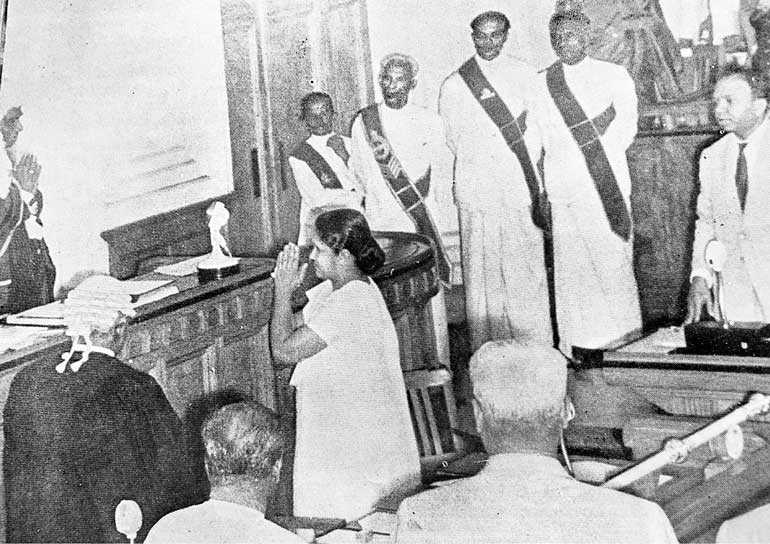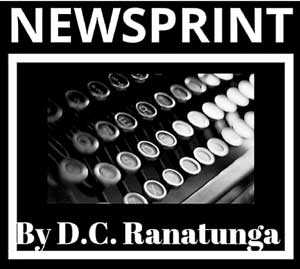Wednesday Dec 10, 2025
Wednesday Dec 10, 2025
Saturday, 25 May 2019 00:00 - - {{hitsCtrl.values.hits}}

Mrs. Bandaranaike greets President of the Senate Sir Cyril de Zoysa after swearing in as a Senator

Mrs. Bandaranaike leaves Queen’s House with son Anura after meeting Governor General Sir Oliver Goonetilleke
Two elections within five months – March and July 1960 – in a country where a general election is normally held once in five years was a record indeed. Candidates, particularly those who contested as Independents, had learnt a bitter lesson. Most of them had lost their deposits in the 1960 March election subscribing to the State coffers. Their numbers came down drastically in July, from 167 to 39 – a drop of 128.
The media, of course, was having plenty to report although the numbers had dropped. From 898 candidates in March, the total came down to 391 with the two leading parties accounting for 226 – UNP 128 and SLFP 98. Other parties fielded 127.
Realising the need for a change in leadership, the SLFP succeeded in convincing Mrs. Bandaranaike to lead the party. She was not keen on contesting but it was agreed that if the party won she would be the prime minister. A no-contest pact between the SLFP and the left parties made things difficult for the UNP.
The results saw 75 SLFP candidates (out of 95) winning while the UNP after fielding 128 won only 30. The Federal Party came third with 16MPs out of 20, followed by the LSSP 12 of 21, CP 4 from 7, MEP 3 from 55, Jathika Vimukthi Peramuna 2 from 2, LPP 2 from 6 and Tamil Congress 1 from 10. Six independents had dropped to six from 39.
Since she had not contested a seat Mrs. B was nominated to the Senate on 5 August. Earlier, when she took her oaths on 21 July she created history not only as the first and only Prime Minister of Sri Lanka who did not sit in the House of Reps, but the first woman PM in the world as well.
The Government decided to continue the socialist programme started during the earlier Bandaranaike regime. With the setting up of the Sri Lanka Insurance Corporation and the Petroleum Corporation, the businesses earlier run by the private sector were made State enterprises.
In 1961 Bank of Ceylon was made a State entity and opening of accounts by Sri Lankans and local companies were restricted. The People’s Bank was opened mainly to serve the rural businessmen and to popularise the banking habit among the rural people.
Amidst agitation private schools were nationalised.
 A distinct change in Government policy was seen and a stable Government had been established.
A distinct change in Government policy was seen and a stable Government had been established.
Writing in ‘Sirimavo’ – a felicitation volume edited by Tissa Jayatilaka – Parliamentary Secretary General Sam Wijesinghe wrote: “Although unencumbered by high learning Mrs. Bandaranaike possessed ample common sense and high integrity—character traits that stood her in good stead on her elevation to the high office she now held. Additionally, Mrs. Bandaranaike was tenacious, purposeful, gritty, had an eye and ear of essentials and possessed steely determination – qualities that sustained her and served the nation well in the next four decades despite the ordeals and reversals she suffered post-1977.”
While we had news about the new Government’s policies and plans, much more sensational news flowed in when a few former Army personnel attempted a coup in 1962. However, the Government subdued it.
And then came the news that Sir Oliver G. was being removed. No sooner the news were heard we managed to track down his movements and found him attending a ceremony at the Police grounds, Bambalapitiya. He was in his official attire.
We also heard of the appointment of one-time Ambassador in United States, Wiliiam Gopallawa, as the Governor-General. While checking his whereabouts with his son Asoka by a university colleague who was on our staff, we were told he was at the home of Dr. Mackie Ratwatte, his son-in-law, Mrs. B’s brother. We rushed another photographer there, having dispatched one earlier to Police Park to get pictures of Sir Oliver.
Next morning’s ‘Dinamina’ carried a simple headline: ‘Sir Oliver yayi: Gopallawa eyi’ (‘Sir Oliver goes: Gopallawa comes’) with pictures right across the page – Sir Oliver in official garb and Gopallawa in a shirt and sarong with the family smiling away. The pictures conveyed the different personalities
A new era had dawned.